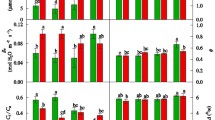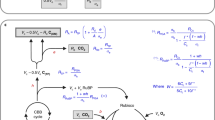Summary
Carbon isotope composition (13C/12C) in leaves of the Panamanian epiphytic orchid Catasetum viridiflavum were measured on individuals growing in canopies over a water surface to distinguish the effects of a change in source CO2 and humidity from those of intercellular CO2 concentration in determining isotopic composition. Carbon isotope ratios were observed to vary by over 4 in response to changes in total daily photon flux (PFD, 400–700 nm). Changes in isotopic composition of source CO2 or changes in humidity were not likely to have played a role in determining leaf isotopic composition. Observed changed in carbon isotope discrimination (Δ) of leaves experiencing different light levels ranged from 17 to 21. Because leaf nitrogen contents were similar among all orchids, we suggest that the carbon isotope discrimination data indicated that stomatal limitation to photosynthesis increased with increasing irradiance.
Similar content being viewed by others
References
Becker P (1987) Monthly average solar radiation in Panama — daily and hourly relationships between direct and global insolation. Solar Energy 39:445–453
Becker P, Erhart DW, Smith AP (1989) Analysis of forest light environments. Part I. Computerized estimation of solar radiation from hemispherical canopy photographs. Agric Forest Meteorol 44:217–232
Benzing DH, Bent A, Moscow D, Peterson G, and Renfrow A (1982) Functional correlates of deciduousness in Catasetum integerrimum (Orchidaceae). Selbyana 7:1–9
Ehleringer JR, Björkman O (1977) Quantum yields for CO2 uptake in C3 and C4 plants: dependence on temperature, carbon dioxide, and oxygen concentration. Plant Physiol 59:86–90
Ehleringer JR, Field CB, Lin ZF, Kuo CY (1986) Leaf carbon isotope ratio and mineral composition in subtropical plants along an irradiance cline. Oecologia 70:520–526
Ehleringer JR, Lin ZF, Field CB, Sun GC, Kuo CY (1987) Leaf carbon isotope ratios of plants from a subtropical monsoon forest. Oecologia 72:109–114
Evans JR (1989) Photosynthesis and nitrogen relationships in leaves of C3 plants. Oecologia 78:9–19
Farquhar GD, Ball MC, von Caemmerer S, Roksandic Z (1982) Effect of salinity and humidity on δ13C value of halophytes-evidence for diffusional isotope fractionation determined by the ratio of intercellular/atmospheric partial pressure of CO2 under different environmental conditions. Oecologia 52:121–124
Farquhar GD, O'Leary MH, Berry JA (1982) On the relationship between carbon isotope discrimination and intercellular carbon dioxide concentration in leaves. Aust J Plant Physiol 9:121–137
Farquhar GD, Ehleringer JR, Hubick KT (1989) Carbon isotope discrimination and photosynthesis. Ann Rev Plant Physiol 40:503–537
Farquhar GD, Richards RA (1984) Isotopic composition of plant carbon correlates with water-use efficiency of wheat genotypes. Aust J Plant Physiol 11:539–552
Francey RJ, Gifford RM, Sharkey TD, Wier B (1985) Physiological influences on carbon isotope discrimination in huon pine (Lagarostrobos franklinii). Oecologia 66:211–218
Guy RD, Reid DM, Krouse HR (1980) Shifts in carbon isotope ratios of two C3 halophytes under natural and artificial conditions. Oecologia 44:241–247
Howell TA, Meek DW, Hatfield JL (1983) Relationship of photosynthetically active radiation to shortwave radiation in the San Joaquin Valley. Agric Meteorol 28:157–175
Kirschbaum MUF, Pearcy RW (1988) Gas exchange analysis of the relative importance of stomatal and biochemical factors in photosynthetic induction in Alocasia macrorrhiza. Plant Physiol 86:782–785
Leigh EG Jr, Rand AS, Windsor DM, eds, (1982) The ecology of a tropical forest, seasonal rhythms and long-term changes. Smithsonian Institution Press, Washington, District of Columbia, USA
Lemon E, Allen LH Jr, Muller L (1970) Carbon dioxide exchange of a tropical rain forest. BioScience 20:1054–1059
Martin B, Nienhuis J, King G, Schaefer A (1989) Restriction fragment length polymorphisms associated with water use efficiency in tomato. Science 243:1725–1728
Masle J, Farquhar GD (1988) Effects of soil strength on the relation of water-use efficiency and growth to carbon isotope discrimination in wheat seedlings. Plant Physiol 86:32–38
Medina E, Minchin P (1980) Stratification of δ13C values of leaves in Amazonian rain forests. Oecologia 45:377–378
Medina E, Montes G, Cuevas E, Roksandic Z (1986) Profiles of CO2 concentration of δ13C values in tropical rainforests of the upper Rio Negro Basin, Venezuela. J Trop Ecol 2:207–217
Mulkey SS (1986) Photosynthetic acclimation and water-use efficiency of three species of understory herbaceous bamboo (Gramineae) in Panama. Oecologia 70:514–519
Pearcy RW (1987) Photosynthetic gas exchange responses of Australian tropical forest trees in canopy, gap, and understory micro-environments. Funct Ecol 1:169–178
Rand AS, Rand WM (1982) Variation in rainfall on Barro Colorado Island. In: Leigh EG Jr, Rand AS, Windsor DM (eds), pp. 47–59. The ecology of a tropical forest, seasonal rhythms and long-term changes. Smithsonian Institution Press, Washington, District of Columbia, USA
Rundel PW, Ehleringer JR, Nagy KA (1988) Stable Isotopes in Ecological Research. Springer Berlin Heidelberg New York
Schleser GH, Jayasekera R (1985) 13C-variations of leaves in forests as an indication of reassimilated CO2 from the soil. Oecologia 65:536–542
Smith BN, Oliver J, McMillan C (1976) Influence of carbon source, oxygen concentration, light intensity and temperature on 13C/12C ratios for higher plants. Bot Gaz 137:99–104
Sternberg LSL, Mulkey SS, Wright SJ (1989) Ecological interpretation of leaf carbon isotope ratios: influence of respired carbon dioxide. Ecology 70:1317–1324
Vogel JC (1978) Recycling of carbon in a forest environment. Oecol Plant 13:89–94
Winter K, Holtum JAM, Edwards GE, O'Leary M (1982) Effect of low relative humidity on δ13C in two C3 grasses and in Panicum milioides, a C3−C4 intermediate species. J Exp Bot 33:88–91
Zimmerman JK (1989) Evolutionary ecology of Catasetum viridiflavum, an orchid that changes sex. Ph.D. Dissertation, University of Utah, Salt Lake City UT, USA
Zimmerman JK, Roubik DW, Ackerman JD (1989) Asynchronous phenologies of a neotropical orchid and its euglossine bee pollinator. Ecology 70:1192–1195
Author information
Authors and Affiliations
Rights and permissions
About this article
Cite this article
Zimmerman, J.K., Ehleringer, J.R. Carbon isotope ratios are correlated with irradiance levels in the Panamanian orchid Catasetum viridiflavum . Oecologia 83, 247–249 (1990). https://doi.org/10.1007/BF00317759
Received:
Accepted:
Issue Date:
DOI: https://doi.org/10.1007/BF00317759




